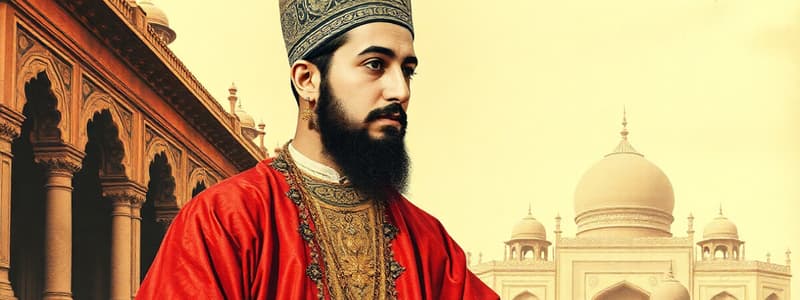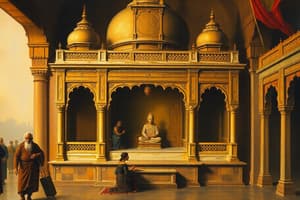Podcast
Questions and Answers
Who led the Turkish armies that devastated Indian cities and temples?
Who led the Turkish armies that devastated Indian cities and temples?
- Babur
- Humayun
- Sultan Mahmud of Ghazni (correct)
- Timur the Lame
What was the name of the empire established by Turkish warlords with Delhi as its capital?
What was the name of the empire established by Turkish warlords with Delhi as its capital?
- The Timur Empire
- The Delhi Sultanate (correct)
- The Mughal Empire
- The Ghazni Empire
Which area did Babur inherit as an 11-year-old?
Which area did Babur inherit as an 11-year-old?
- Delhi
- Uzbekistan and Tajikistan (correct)
- Agra
- Kabul
Who laid the foundation for the Mughal Empire in India?
Who laid the foundation for the Mughal Empire in India?
Which language was commonly spoken by people during Akbar's rule, blending Persian and a local language?
Which language was commonly spoken by people during Akbar's rule, blending Persian and a local language?
What are the small, highly detailed, and colorful paintings from the Mughal court called?
What are the small, highly detailed, and colorful paintings from the Mughal court called?
What is the Akbarnamah?
What is the Akbarnamah?
What is the name of the architectural style that developed under Akbar's reign?
What is the name of the architectural style that developed under Akbar's reign?
Why did Akbar build the city of Fatehpur Sikri?
Why did Akbar build the city of Fatehpur Sikri?
What does the name 'Akbar' mean?
What does the name 'Akbar' mean?
With what did Akbar equip his armies, similar to the Safavids and Ottomans?
With what did Akbar equip his armies, similar to the Safavids and Ottomans?
What did Akbar do with some Rajputs to turn them into allies?
What did Akbar do with some Rajputs to turn them into allies?
What was Akbar's religion?
What was Akbar's religion?
How did Akbar demonstrate his tolerance for other religions?
How did Akbar demonstrate his tolerance for other religions?
What tax did Akbar abolish to show his religious tolerance?
What tax did Akbar abolish to show his religious tolerance?
What new language emerged as a result of cultural blending during Akbar's rule?
What new language emerged as a result of cultural blending during Akbar's rule?
Flashcards
Delhi Sultanate
Delhi Sultanate
Turkish warlords that formed a loose empire with Delhi as their capital.
Unifying Leader
Unifying Leader
The leader who unified the empire in the 16th century after the Delhi Sultanate was destroyed.
Babur
Babur
He inherited a tiny kingdom, built up an army, and laid the foundation for the Mughal Empire in India.
Mughal Empire
Mughal Empire
Signup and view all the flashcards
Humayun
Humayun
Signup and view all the flashcards
Persian Language in Mughal Empire
Persian Language in Mughal Empire
Signup and view all the flashcards
Hindi Language
Hindi Language
Signup and view all the flashcards
Urdu Language
Urdu Language
Signup and view all the flashcards
Mughal Miniatures
Mughal Miniatures
Signup and view all the flashcards
Fatehpur Sikri
Fatehpur Sikri
Signup and view all the flashcards
Who was Akbar?
Who was Akbar?
Signup and view all the flashcards
Akbar's Military Strategies
Akbar's Military Strategies
Signup and view all the flashcards
Akbar's Unification
Akbar's Unification
Signup and view all the flashcards
Akbar's Religious Tolerance
Akbar's Religious Tolerance
Signup and view all the flashcards
Akbar's Cultural Impact
Akbar's Cultural Impact
Signup and view all the flashcards
Akbar's inclusive Governance
Akbar's inclusive Governance
Signup and view all the flashcards
Akbar's governing system
Akbar's governing system
Signup and view all the flashcards
Language Development
Language Development
Signup and view all the flashcards
Study Notes
- Mughals means “Mongols.”
Early History
- Sultan Mahmud of Ghazni led forces that devastated Indian cities and temples.
- Delhi became the capital of the Delhi Sultanate, a loose empire of Turkish warlords.
- Continuous bloody clashes occurred between Hindus and Muslims during the 8th century.
- Well-trained Turkish armies swept into India 300 years later.
- The sultans treated the Hindus as conquered people.
Delhi Sultanate
- In 1398, Timur the Lame destroyed Delhi, which was later rebuilt.
- It wasn't until the 16th century that a leader emerged to unify the empire.
- Between the 13th and 16th centuries, 33 sultans ruled the divided territory from Delhi.
Babur Founds an Empire
- In 1494, 11-year-old Babur inherited a small kingdom in present-day Uzbekistan and Tajikistan, but his elders soon took it away.
- Babur built up an army and swept into India, laying the foundation for the vast Mughal Empire.
- Babur was a brilliant general who, in 1526, led 12,000 troops to victory against a 100,000-strong army commanded by a sultan of Delhi, and also defeated a massive Rajput army a year later.
- After Babur's death, his son Humayun lost most of the territory Babur had gained.
- Babur's 13-year-old grandson then took over the throne after Humayun's death.
Akbar's Golden Age
- Babur's grandson, Akbar, whose name means "Greatest One," ruled India with wisdom and tolerance from 1556 to 1605.
Military Conquest
- Akbar, like the Safavids and the Ottomans, equipped his armies with heavy artillery and appointed some Rajputs as officers.
- Akbar recognized military power as the root of his strength, turning potential enemies into allies.
- Military power and political wisdom combined enabled Akbar to unify a land of at least 100 million people.
Liberal Rule
- Akbar was a Muslim who defended religious freedom and permitted people of other religions to practice their faiths.
- He proved his tolerance by marrying two Hindus, a Christian, and a Muslim, among others and allowed his wives to practice their religious rituals in the palace.
- Akbar abolished the tax on Hindu pilgrims and on non-Muslims.
- Natives and foreigners, Hindus and Muslims, could all rise to high office.
- This approach contributed to the quality of his government.
- Akbar governed through a bureaucracy of officials and gave generous land grants to his bureaucrats that were redistributed after their death.
Flowering of Culture
- Cultural blending during Akbar's rule affected art, education, politics, and language.
- The languages during this time were Persian, Hindi, and Urdu.
- Persian was the language of Akbar's court and of high culture.
- Hindi was a mixture of Persian and a local language spoken by common people.
- Urdu, a blend of Arabic, Persian, and Hindi, was created due to the blending of different cultures in the army and became the official language of Pakistan today.
- As Akbar extended the Mughal Empire, he welcomed influences from the many cultures in the empire.
Arts and Literature
- The arts flourished at the Mughal court, especially in the form of book illustrations.
- Small, highly detailed, colorful paintings were called miniatures.
- Some of the most famous Mughal miniatures adorned the Akbarnamah ("Book of Akbar"), which tells the story of the emperor's campaigns and deeds.
- Indian art drew from Western traditions, and Hindu literature enjoyed a revival in Akbar's time.
Architecture
- Massive but graceful structures are decorated with intricate stonework that portrays Hindu themes.
- The capital city of Fatehpur Sikri is one of the most important examples of this type of architecture.
- Akbar also devoted himself to architecture
- The style developed under his reign is still known as Akbar period architecture.
- Akbar had this red-sandstone city built to thank a holy man who had predicted the birth of his first son.
Studying That Suits You
Use AI to generate personalized quizzes and flashcards to suit your learning preferences.




